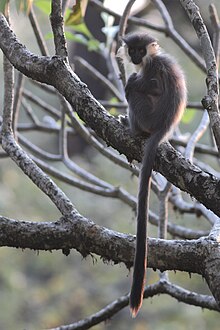The capped langur (Trachypithecus pileatus) is a primate species in the family Cercopithecidae native to subtropical and tropical dry forests in northeast India, Bhutan, Bangladesh and Myanmar. It is arboreal and feeds on 43 plant species.
| Capped langur | |
|---|---|

| |
| Capped langur in Manas National Park | |
| Scientific classification | |
| Domain: | Eukaryota |
| Kingdom: | Animalia |
| Phylum: | Chordata |
| Class: | Mammalia |
| Order: | Primates |
| Suborder: | Haplorhini |
| Infraorder: | Simiiformes |
| Family: | Cercopithecidae |
| Genus: | Trachypithecus |
| Species: | T. pileatus[1]
|
| Binomial name | |
| Trachypithecus pileatus[1] (Blyth, 1843)
| |

| |
| Capped langur range | |
Taxonomy
editThe capped langur was described by Edward Blyth in 1843. Four subspecies of the capped langur are recognized as of 2005:[1]
- T. p. pileatus
- T. p. durga
- T. p. brahma
- T. p. tenebricus
Distribution and habitat
editThe capped langur occurs in northeast India, Bhutan, Bangladesh and Myanmar, where it inhabits subtropical and tropical dry forests.[2]
Behavior and ecology
editCapped langurs observed in Arunachal Pradesh spent nearly 40% of the day time feeding on leaves, flowers and fruits. Leaves contributed nearly 60% of the diet, and they foraged on as many as 43 different plant species.[3]
References
edit- ^ a b Groves, C. P. (2005). "Species Trachypithecus pileatus". In Wilson, D. E.; Reeder, D. M. (eds.). Mammal Species of the World: A Taxonomic and Geographic Reference (3rd ed.). Baltimore: Johns Hopkins University Press. p. 177. ISBN 0-801-88221-4. OCLC 62265494.
- ^ a b c Das, J.; Chetry, D.; Choudhury, A. & Bleisch, W. (2020). "Trachypithecus pileatus". IUCN Red List of Threatened Species. 2020: e.T22041A196580469. doi:10.2305/IUCN.UK.2020-3.RLTS.T22041A196580469.en. Retrieved 17 January 2022.
- ^ Solanki, G.S.; Kumar, A & Sharma, B.K. (2008). "Winter food selection and diet composition of capped langur (Trachypithecus pileatus) in Arunachal Pradesh, India". Tropical Ecology. 49 (2): 157–166.
